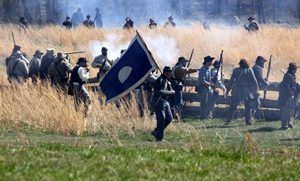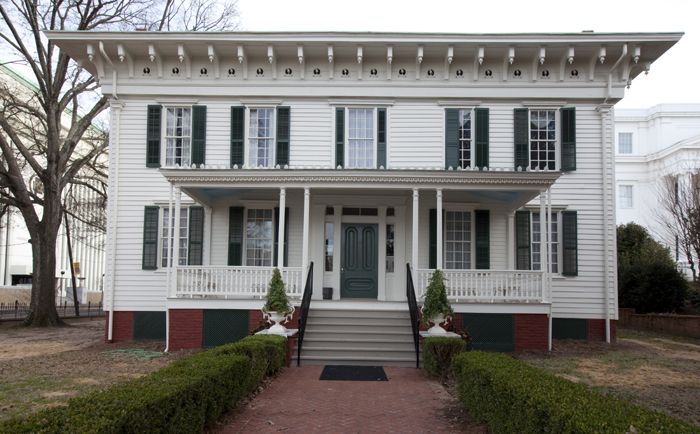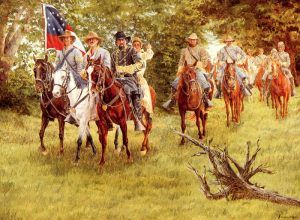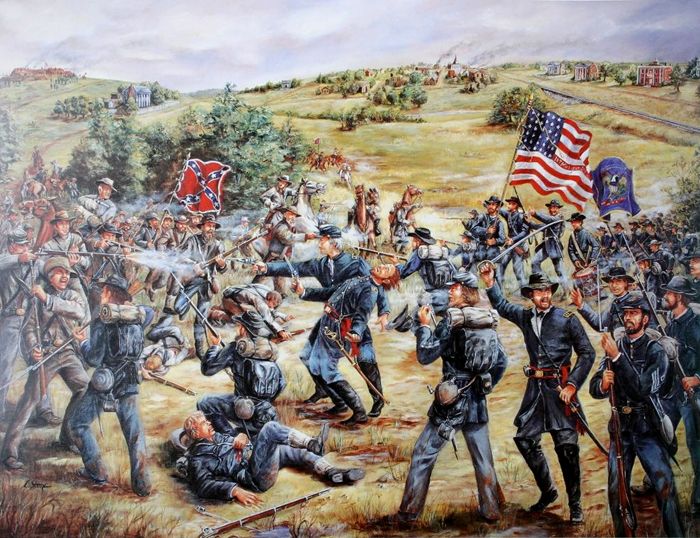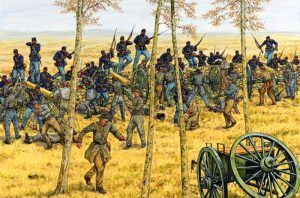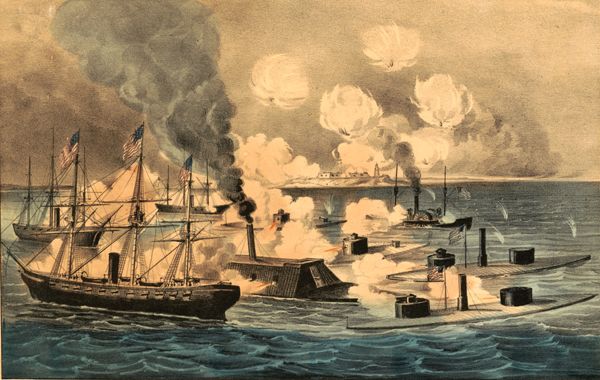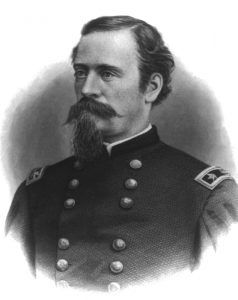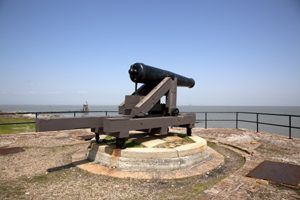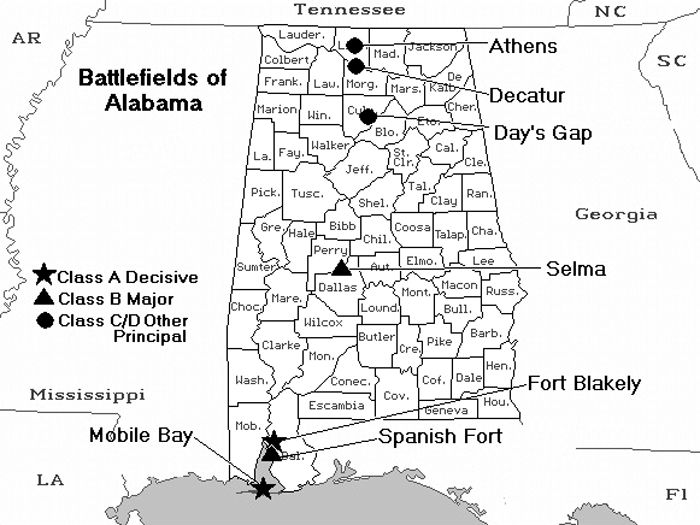
Battlefields of Alabama.
The birthplace of the Confederacy, the State of Alabama, was central to the Civil War. For years tensions had been building before Abraham Lincoln was elected president in November 1860. Afterward, many politically powerful Alabamians viewed the election as an opening wedge that threatened to destroy slavery, and across the state came cries for state rights.
Governor A. B. Moore took several decisive steps to safeguard the state’s financial status and defensive capabilities. He ordered the state militia to seize the arsenal at Mt. Vernon and Forts Morgan and Gaines on Mobile Bay. He contributed more than 500 troops to assist Florida Governor Madison S. Perry in capturing the Federal forts at Pensacola. He then called for a constitutional convention, and on January 11, 1861, Alabama passed an Ordinance of Secession, declaring Alabama a “Sovereign and Independent State.” From January through March, Alabama invited other states to form a Southern Republic and develop constitutions to run their own affairs legally. On February 4, 1861, delegates from six states that had recently seceded from the Union met in Montgomery, Alabama, to establish the Confederate States of America. Four days later, this provisional Confederate Congress, comprising representatives of Alabama, Florida, Georgia, Louisiana, Mississippi, and South Carolina, organized the Confederacy by adopting a provisional constitution. On February 22, Jefferson Davis was inaugurated as president of the Confederate States of America in Montgomery, Alabama, which served as the Confederate capital until it was moved to Richmond, Virginia, in May.
Alabama provided numerous troops and leaders, military materials, supplies, food, horses, and mules to their cause during the war. The state was not the scene of any significant military operations, yet it contributed about 120,000 men to the Confederate service, practically all of the white population capable of bearing arms. Most were recruited locally and served with men they knew, which built morale and strengthened ties to home. Medical conditions were severe; about 15% died of disease and 10% from battle. Alabama had few well-equipped hospitals, but many women volunteered to nurse the sick and wounded. Soldiers were poorly equipped, especially after 1863, and often resorted to pillaging the dead for boots, belts, canteens, blankets, hats, shirts, and pants.
Uncounted thousands of slaves worked with Confederate troops; they took care of horses and equipment, cooked and did laundry, hauled supplies, and helped in field hospitals. Other slaves built defensive installations, especially those around Mobile. They graded roads, repaired railroads, drove supply wagons, and labored in iron mines, iron foundries, and even munitions factories. As they were enslaved, the labor of slaves was involuntary; their unpaid labor was forcibly impressed by their unpaid masters. About 10,000 slaves escaped and joined the Union Army, along with 2,700 white men loyal to the Union.
In 1863 Federal forces secured a foothold in northern Alabama despite spirited opposition from Confederate cavalry under General Nathan B. Forrest. The Alabama ports remained open at the southern coast for almost four years until the Battle of Mobile Bay in August 1864. The Battle of Fort Blakeley in April 1865 forced Mobile to surrender the last major Confederate port.
Alabama Campaigns and Battles:
Streight’s Raid in Alabama – April-May 1863 – Union Colonel Abel D. Streight led a raid through Alabama and Georgia from April 19 to May 3, 1863. He aimed to destroy parts of the Western and Atlantic Railroad, supplying the Confederate Army of Tennessee. The raid was poorly supplied and planned and was hindered by locals who had the advantage of home territory and opposed the Union. The raid ended with the defeat and capture of Streight and his 1,700 men at Cedar Bluff, Alabama, by Confederate Brigadier General Nathan Bedford Forrest, who had 500 men.
Day’s Gap – April 30, 1863 – Also called the Battle of Sand Mountain, this battle occurred in Cullman County, Alabama, on April 30, 1863. Union Colonel Abel D. Streight led a provisional brigade on a raid to cut the Western & Atlantic Railroad that supplied General Braxton Bragg’s Confederate army in Middle Tennessee. From Nashville, Tennessee, Streight’s command traveled to Eastport, Mississippi, then proceeded east to Tuscumbia, Alabama, in conjunction with another Union force commanded by Brigadier General Grenville Dodge. On April 26, 1863, Streight’s men left Tuscumbia and marched southeast, with their initial movements screened by Dodge’s troops. On April 30, Confederate Brigadier General Nathan Bedford Forrest’s brigade caught up with Streight’s expedition and attacked its rearguard at Day’s Gap on Sand Mountain. The Federals repulsed this attack and continued their march to avoid further delay and envelopment. Thus began a series of skirmishes and engagements at Crooked Creek and Hog Mountain on April 30, Blountsville on May 1, and Black Creek/Gadsden and Blount’s Plantation on May 2. Forrest finally surrounded the exhausted Union soldiers near Rome, Georgia, where he forced their surrender on May 3. The running battle resulted in a Union victory, though Streight’s Raid ultimately failed. Total casualties were estimated at 88, with 23 from the Union and 65 from the Confederate.
Operations in North Alabama, 1864
Athens – January 26, 1864 – Also called the Battle of Sulphur Creek Trestle, this battle took place in Limestone County on January 26, 1864. This battle occurred when the Confederate cavalry, led by Lieutenant Colonel Moses W. Hannon, led about 600 men in attacking Athens, Alabama, which was being held by Union troops. At about 4:00 am on the morning of January 26, 1864, the Rebels attacked Union Captain Emil Adams and his force of about 100 soldiers. Even though the Union defenders had no fortifications and were outnumbered six to one, they could repulse the Confederate attack and force them into a retreat after a two-hour battle. The Union victory resulted in an estimated 50 casualties – 20 Union and 30 Confederate.
Franklin-Nashville Campaign, 1864 – The Franklin-Nashville Campaign, also known as Hood’s Tennessee Campaign, was a series of battles in the Western Theater, conducted from September 18 to December 27, 1864, in Alabama, Tennessee, and northwestern Georgia. The Confederate Army of Tennessee under Lieutenant General John Bell Hood drove north from Atlanta, threatening Major General William T. Sherman’s lines of communications and central Tennessee. After a brief attempt to pursue Hood, Sherman returned to Atlanta and began his March to the Sea, leaving Union forces under Major General George H. Thomas to deal with Hood’s threat. The first two battles of the campaign were fought in Allatoona, Georgia, and Decatur, Alabama. Six more battles would be fought in Tennessee before the campaign ended.
Decatur – October 26-29, 1864 – Taking place in Morgan County and Limestone Counties, on October 26-29, 1864, this battle was part of Confederate General John B. Hood’s Franklin-Nashville Campaign during the fall of 1864. When Hood was marching through northern Alabama on his way to Union-held Tennessee, he originally planned to cross the Tennessee River at Guntersville, Alabama. However, when he learned that it was highly guarded, he changed directions and decided to cross at Decatur, 40 miles to the west. When he and his troops arrived on October 26, they found that this crossing was also heavily fortified with a Federal infantry force of 3,000 to 5,000 men, two forts, two gunboats, and 1,600 yards of rifle pits. On October 27, Hood and his men encircled Decatur, and the next morning, he sent Confederate skirmishers through a dense fog to a ravine within 800 yards of the main fortifications. At about noon, a Federal regiment drove the Confederate troops out of the ravine, capturing 125 men. “With the soldiers hungry and supplies scarce,” Hood knew he could not afford the casualties from a full-scale assault and decided to cross the Tennessee River elsewhere. He then marched further westward and crossed near Tuscumbia, Alabama, where Muscle Shoals prevented the Federal gunboats’ interference. The Union victory resulted in estimated casualties of 155 Union and 450 Confederate.
Mobile Campaign, 1865 – During the Civil War, Mobile, Alabama, was the South’s fourth-largest city and second-largest port city, home to several shipbuilding companies, an economic trade hub. In the Spring of 1865, the Union was determined to take the city, and the Union Army besieged Mobile from March 25 to April 12, 1865. The city was captured on April 12. Two important battles were fought at Spanish Fort and Fort Blakeley.
Spanish Fort – March 27-April 8, 1865 – Occurring in Baldwin County between March 27 and April 8, 1865, this battle took place as Union Major General E.R.S. Canby led his forces along the eastern shore of Mobile Bay. Pushing the Confederate troops back into their defenses, the Union forces then concentrated on Spanish Fort and Fort Blakely. On March 27, Canby’s forces rendezvoused at Danley’s Ferry and immediately undertook a siege of Spanish Fort. The Union had enveloped the fort by April 1 and on April 8, captured it. Under the command of Brigadier General Randall L. Gibson, most of the Confederate forces escaped and fled to Mobile, but Spanish Fort was no longer a threat. The Union victory resulted in estimated casualties of 657 Union and 744 Confederate.
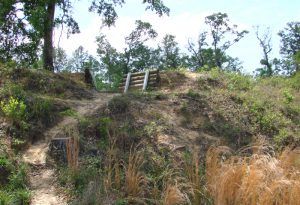
Fort Blakely, Alabama today courtesy Civil War Journeys.
Fort Blakely – April 2-9, 1865 – Taking placed in Baldwin County on April 2-9, 1865, as Union Major General E.R.S. Canby led his forces along the eastern shore of Mobile Bay. Pushing the Confederate troops back into their defenses, the Union forces concentrated on Spanish Fort and Fort Blakely. By April 1, Union forces had enveloped Spanish Fort, releasing more troops to focus on Fort Blakely. Confederate Brigadier General St. John R. Liddell, with about 4,000 men, held out against the much larger Union force until Spanish Fort fell on April 8, allowing Canby to concentrate 16,000 men for the attack on April 9. Sheer numbers breached the Confederate earthworks compelling the Confederates to surrender. The siege and capture of Fort Blakely was the last combined-force battle of the war. African-American forces played a major role in the successful Union assault. The Union victory resulted in estimated casualties of 629 Union and 2,900 Confederate.
Mobile Bay – August 2-23, 1864 – Taking place in Mobile and Baldwin Counties of Alabama August 2-23, 1864, a combined Union force of Army soldiers and the Navy initiated operations to close Mobile Bay to blockade running. Some Union forces landed on Dauphin Island and laid siege to Fort Gaines. On August 5, Admiral David G. Farragut’s Union fleet of 18 ships entered Mobile Bay and received devastating fire from Forts Gaines and Morgan and other points. After passing the forts, Farragut forced the Confederate naval forces, under Admiral Franklin Buchanan, to surrender, which effectively closed Mobile Bay. By August 23, Fort Morgan, the last big holdout, fell, shutting down the port. The city, however, remained uncaptured. The Union victory resulted in estimated casualties of 322 Union and 1,500 Confederate.
Newton – March 14, 1865 – The Battle of Newton was a minor skirmish in the small town of Newton, Alabama, on March 14, 1865, during the final days of the Civil War. It was fought between local Home Guard troops and elements of the 1st Florida Cavalry of the Union, who had invaded the Wiregrass region of Alabama in violation of a directive given by Brigadier General Alexander Asboth, commanding Union forces in Pensacola, Florida. Led by Second Lieutenant Joseph Sanders, a former captain in the Confederate Army who had switched sides and joined with the Federals, the Floridians intended to burn the courthouse of Dale County, located in Newton. However, their movement toward the town was detected by local citizens, and they were ambushed and routed on the town square by Newton’s Home Guard before they could do any damage. Sanders reported three dead and five wounded, while no casualties were reported among the Confederate Home Guard troops.
Wilson’s Raid in Alabama, 1865 – Major General James H. Wilson’s Raid was a cavalry operation through Alabama and Georgia in March and April 1865. Wilson led approximately 13,500 men in three divisions to destroy Southern manufacturing facilities. He and his men were opposed unsuccessfully by a much smaller force under Confederate Lieutenant General Nathan Bedford Forrest, with about 2,500 troopers. The raid consisted of four battles – Tuscaloosa and Selma in Alabama and West Point and Columbus in Georgia. It was a great success as Wilson and his men captured four fortified cities, 288 cannons, and 6,820 prisoners.
Tuscaloosa – March 31-April 4, 1865 – During Major General James H. Wilson’s Raid of Alabama and Georgia, he detached a 1,500-man brigade under Brigadier General John T. Croxton. He sent them south and west to burn the Roupes Valley Ironworks at Tannehill and Bibb Naval Furnace at Brierfield on March 31. They then burned the University of Alabama at Tuscaloosa, a prominent military school, on April 4. This movement diverted Confederate Brigadier General James R. Chalmers’ division away from General Nathan Bedford Forrest’s main force.
Ebenezer Church – April 1, 1865 – This battle was fought near Plantersville, Alabama, between Union Army cavalry under Major General James H. Wilson and his troops against the Confederate States Army cavalry under Major General Nathan Bedford Forrest on April 1, 1865. Forrest had at least 1,500 and as many as 5,000 troops, but some were ill-trained Alabama State Troops. Wilson had at least 9,000 troopers of his original 13,480-man force available. Forrest had been unable to concentrate scattered Confederate forces to face Wilson’s larger force, armed with 7-shot Spencer repeating carbines. After a brief but initially heavy engagement, the Alabama State Troops’ line broke, and Wilson’s men drove the Confederates back toward the defenses of Selma, Alabama. Selma had an arsenal and industry that Wilson attacked and destroyed after his men again defeated the Confederate troopers at the Battle of Selma the following day. After the battle at Ebenezer Church, the Union troops burned the railroad depot at Plantersville and a cotton warehouse. Confederate casualties were not reported, but Wilson’s force captured 300 of Forrest’s men and three artillery pieces. Wilson’s command had 12 killed and 40 wounded. Forrest received a slight saber wound, which he later said would have been fatal if the Union officer, Captain James D. Taylor, had struck him with the point rather than the blade. Forrest killed Taylor, the last of 33 men he killed during the war, with a pistol shot.
Selma – April 2, 1865 – Taking place in Dallas County, Alabama, on April 2, 1865, this battle occurred after Major General James H. Wilson led his men south from Gravelly Springs, Alabama, on March 22, 1865. Opposed by Confederate Lieutenant General Nathan B. Forrest, Wilson skillfully continued his march and eventually defeated him in a running battle at Ebenezer Church on April 1. Continuing towards Selma, Wilson split his command into three columns. Although Selma was well-defended, the Union columns broke through the defenses at separate points forcing the Confederates to surrender the city. However, many of the officers and men, including Forrest and Lieutenant General Richard Taylor, escaped. Selma demonstrated that even Forrest, whom some had considered invincible, could not stop the unrelenting Union movements deep into the Southern Heartland. The Union victory resulted in estimated casualties of 319 Union and 2,700 Confederate.
Munford – April 23, 1865 – The Battle of Munford took place in Munford, Alabama, on Sunday, April 23, 1865, during the raid through the state by 1,500 Union Army cavalrymen under General John T. Croxton, part of the force participating in Wilson’s Raid. The Battle of Munford and a minor action at Hendersonville, North Carolina, on the same day were the last battles of the American Civil War in the Eastern Theater of the American Civil War (east of the Mississippi River). The Confederate soldiers in the battle were described as convalescents, home guards, and pardoned deserters, while the Union cavalry was a veteran force armed with 7-shot Spencer repeating carbines. General Benjamin Jefferson Hill commanded the Confederate forces. Confederate Lieutenant Lewis E. Parsons had two cannons, which fired a couple of rounds before they were overrun. The Union troops quickly won the brief battle. Parsons was appointed the provisional governor of Alabama in June after the war’s end. One Union trooper and one Confederate killed that day are described by author Rex Miller as the last to die in open combat by contending military forces.
Compiled and edited by Kathy Alexander/Legends of America, updated January 2023.
Also See:
Western Theater of the Civil War
Sources:

